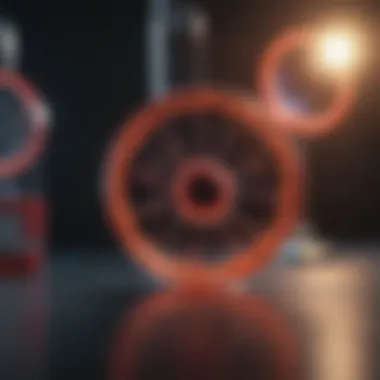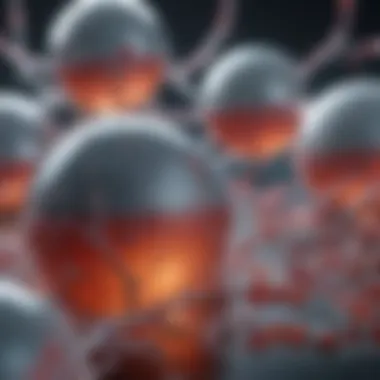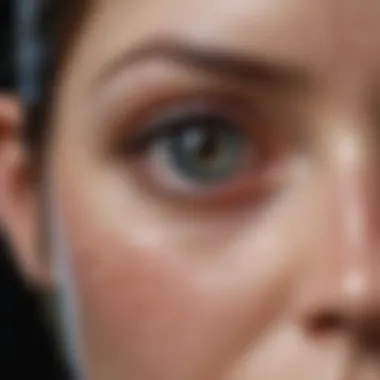Stem Cell Innovations for Treating Quadriplegia


Intro
The exploration of stem cells in the context of quadriplegia offers a promising frontier in medical science. With the potential to restore function in individuals affected by paralysis, stem cell therapy has evolved into a topic of critical importance. Quadriplegia, resulting from severe spinal cord injuries, often leads to a life of limited mobility and independence. Therefore, understanding this therapy's role gives hope and insight into innovative rehabilitation strategies.
The subsequent sections will delve into research highlights, original research articles, and insights into clinical practices. This narrative aims to present a detailed examination of current developments in this field while addressing the ethical considerations inherent in stem cell research. Analyzing real-world case studies will further enrich our understanding. Together, these components will offer a comprehensive perspective on stem cell therapy for quadriplegics.
Preface to Quadriplegia
Quadriplegia represents a significant health challenge, impacting individuals profoundly. Understanding the fundamental concepts related to this condition is crucial. This introduction provides background on quadriplegia, its implications, and the transformative potential of stem cells in its treatment. By laying a solid foundation, we aim to equip readers with the knowledge necessary for comprehending the complexities of stem cell therapy.
Definition and Overview
Quadriplegia, or tetraplegia, is characterized by the loss of motor and sensory function in arms and legs due to spinal cord injury or disease. It can occur from various causes, leading to differing degrees of impairment. This condition affects not only physical capabilities but also emotional and social functioning. Awareness of what quadriplegia entails is vital for appreciating the advancements in treatment options.
The implications of quadriplegia can be far-reaching. Individuals may face challenges in daily activities, personal care, and mobility. Understanding the definition allows for a more profound empathy towards the affected individuals. Moreover, this knowledge sets the stage for exploring innovative treatments like stem cell therapy, which may offer renewed hope for restoration of function.
Causes and Types
Quadriplegia can arise from a myriad of causes, each contributing to its complexity. The primary causes include:
- Trauma: Accidents resulting in spinal cord injury, such as falls, vehicle accidents, or sports injuries commonly lead to quadriplegia.
- Diseases: Conditions like multiple sclerosis, amyotrophic lateral sclerosis, or spinal cord tumors can contribute significantly.
Each case of quadriplegia has distinct characteristics, prompting the classification into several types, such as complete and incomplete quadriplegia. In complete quadriplegia, there is total absence of sensory and motor function below the site of the injury. Conversely, incomplete quadriplegia may retain some sensation or movement, giving it a more variable presentation.
Understanding these causes and types is essential, as it informs both the medical approach and potential treatment options available, such as stem cell therapies, which hold promise for recovery and rehabilitation.
Understanding Stem Cells
Understanding stem cells is crucial in the context of quadriplegia and its treatment. Stem cells offer a potential avenue for regeneration and repair of damaged spinal cord tissue. They possess the unique ability to differentiate into various cell types, which is essential in therapies targeting the restoration of lost motor functions.
Stem cells can modulate immune responses and promote healing. This is particularly relevant for patients with quadriplegia, as their condition often involves significant inflammation and damage to nerve pathways. By grasping the mechanisms by which stem cells operate, researchers and practitioners can develop more effective therapeutic interventions tailored for individuals affected by paralysis.
Types of Stem Cells
Embryonic Stem Cells
Embryonic stem cells are derived from early-stage embryos, specifically from the inner cell mass. These cells are pluripotent, meaning they can give rise to almost any cell type in the body. Their versatility makes them a potentially powerful choice in stem cell therapy for quadriplegics. In the context of spinal cord injuries, embryonic stem cells can differentiate into neurons and glial cells, which could help rebuild damaged connections.
However, ethical concerns surrounding the use of embryonic stem cells cannot be overlooked. Many researchers face debates regarding the moral implications of using embryonic tissue. Additionally, there is a risk of tumor formation post-implementation, which is a significant disadvantage in clinical applications.
Adult Stem Cells
Adult stem cells are found in various tissues, including bone marrow and adipose (fat) tissue. These cells have a more limited differentiation capacity compared to embryonic stem cells. Nonetheless, adult stem cells are advantageous because they can be sourced from the patient’s own body, minimizing the risk of rejection in transplant scenarios. Their relative stability and lower ethical challenges make them a popular subject in ongoing research for restoring motor function in quadriplegics.
The unique aspect of adult stem cells is their ability to generate specific types of cells, such as muscle or nerve cells, pertinent in the rehabilitation process. However, their limited versatility compared to embryonic stem cells poses a challenge, as they may not fully replace the desired cell types required for optimal recovery.
Induced Pluripotent Stem Cells
Induced pluripotent stem cells (iPSCs) are a breakthrough in stem cell research. They are derived from adult cells that have been genetically reprogrammed to an embryonic stem cell-like state. This remarkable feat allows them to regain pluripotency, enabling researchers to create diverse cell types from easily accessible tissues like skin.
The appeal of iPSCs lies in their potential to overcome the ethical concerns associated with embryonic stem cells, as they do not originate from embryos. This makes them a less controversial option. Furthermore, since iPSCs can be generated from patients’ own cells, there is a lower chance of immune rejection in transplantation.
Nonetheless, the use of iPSCs is still experimental. Risks include potential mutations or abnormal cell growth over time. These factors must be thoroughly addressed before iPSCs can be widely implemented in clinical settings.
Biological Mechanisms


Stem cells operate through several biological mechanisms that enable their therapeutic effects. They can promote neuroregeneration through signaling pathways, which encourage cell survival and growth. Furthermore, stem cells may modulate inflammatory responses within the central nervous system. By understanding these mechanisms, we can refine stem cell therapies to optimize outcomes for quadriplegic patients.
Stem Cell Therapy for Quadriplegics
Stem cell therapy represents a promising frontier in the rehabilitation for quadriplegics. This approach focuses on utilizing the unique properties of stem cells to repair or restore functions lost due to spinal cord injuries. The relevance of stem cell therapy lies in its potential not just for physical recovery, but also for improving neurological function and overall quality of life.
Mechanisms of Action
Neuroregeneration
Neuroregeneration is key in the context of stem cell therapy for quadriplegics. It refers to the process through which new neurons are formed and existing ones are repaired following injury. This can lead to significant restoration of motor and sensory functions. The ability of stem cells to differentiate into neuronal cells and produce growth factors makes them a popular choice in treating spinal cord injuries.
A valuable characteristic of neuroregeneration is its ability to enhance the body’s natural healing processes. It encourages the regeneration of damaged neural pathways, which is crucial for recovery in quadriplegics. However, this process can be influenced by various factors, such as the age of the individual and the severity of their injury.
On the one hand, neuroregeneration offers multiple advantages:
- Potential for Functional Recovery: Patients may regain some motor capabilities.
- Adaptable Treatment Options: Different types of stem cells may be used to enhance outcomes.
However, challenges persist, including:
- Integration Issues: Stem cells might not integrate perfectly within the existing neural structure.
- Limited Understanding: The full extent of neuroregeneration and its effects remain an area of ongoing research.
Inflammation Modulation
Inflammation modulation is another significant mechanism involved in stem cell therapy. After a spinal cord injury, inflammation can lead to secondary damage, further complicating recovery. Stem cells can help regulate this inflammatory response, thereby protecting the neural tissue and enhancing recovery prospects.
A key characteristic of inflammation modulation is its ability to create a more favorable environment for healing. By downregulating harmful inflammatory cytokines and enhancing protective factors, stem cells can mitigate the secondary injury process.
Some benefits of inflammation modulation include:
- Reduction in Secondary Damage: Protects surrounding healthy tissue from inflammatory damage.
- Enhanced Recovery Environment: A less inflammatory environment promotes better healing.
However, there are also some disadvantages:
- Complexity of Immune Response: Responses to stem cell treatments can vary among individuals.
- Potential for Adverse Effects: Modulating inflammation requires precise control to avoid unwanted outcomes.
Potential Benefits
Motor Function Restoration
Motor function restoration is often seen as the primary objective of stem cell therapy in quadriplegics. This aspect focuses on enabling patients to regain mobility and control over their movements. The unique capacity of stem cells to differentiate into various types of cells, including neuronal ones, supports this goal effectively.
One key aspect of motor function restoration is its potential impact on patients' independence and daily living activities. Regaining even limited motor control can lead to a significant improvement in quality of life.
The advantages include:
- Gradual Improvement: Patients may experience progressive gains over time.
- Customization of Regimens: Tailored therapies can address specific motor deficits.
In terms of disadvantages, some factors to consider:
- Uncertain Outcomes: Results can vary widely from one patient to another.
- Duration of Recovery: Restoration may take substantial time and consistent effort.
Enhanced Quality of Life
Enhanced quality of life is not just about physical recovery; it encompasses emotional and psychological dimensions as well. Stem cell therapy can contribute greatly to the overall well-being of quadriplegic patients by improving their ability to engage in social activities and maintain psychological health.
A notable feature is that improved motor functions often coincide with enhanced social interactions, leading to better emotional states. This interconnection between physical and mental health underlines the importance of comprehensive treatment approaches.


With benefits including:
- Increased Social Participation: Patients may feel empowered to participate in daily life.
- Improvements in Mental Health: Recovery can lead to decreased feelings of isolation or depression.
However, there are challenges to the realization of these benefits:
- Individual Variability: Factors like support systems and personal resilience can play a significant role.
- Continued Dependency: Some patients may still experience limitations, affecting their quality of life despite improvements in motor function.
"Stem cell therapy holds not just the promise of physical recovery, but also the potential for emotional and social revitalization essential for a fulfilling life."
Current Research and Clinical Trials
The study of stem cells within the context of quadriplegia is evolving. Current research and clinical trials serve as fundamental pillars in understanding how these cells can potentially aid in recovery and rehabilitation. The implications of ongoing studies extend beyond mere academic interest. They hold the promise of transforming the lives of individuals affected by paralysis. Each research initiative and clinical trial can elucidate new pathways for treatment, providing actionable insights into the mechanisms of stem cell therapy and its effectiveness.
Recent Developments
Recent developments in stem cell research have markedly advanced the understanding of treatments for quadriplegics. Researchers are investigating various types of stem cells. These include embryonic stem cells, adult stem cells, and induced pluripotent stem cells.
Embryonic stem cells are known for their high yield of pluripotent cells. Adult stem cells, however, present fewer ethical concerns, as they can be derived from the patient’s own body. Induced pluripotent stem cells, created by reprogramming adult cells, also offer a promising alternative without the ethical disputes of embryonic sources.
Clinical trials have focused on several key aspects:
- Safety: Evaluating if stem cell treatments can be administrated without severe adverse effects.
- Efficacy: Assessing if these treatments provide meaningful recovery of motor functions.
- Long-Term Outcomes: Observing sustained effects after initial treatment, essential for validating any proposed therapies.
"The application of stem cell therapy in quadriplegia is still in a nascent stage, yet it stands on the verge of moving towards practical applications in clinical settings."
Case Studies
Case studies are vital in morphing theoretical possibilities into practical realities. They offer concrete evidence of stem cell therapy's effectiveness or limitations in real-world scenarios. Many trials are underway, and several have reported initial findings.
For instance, a significant case involved a patient with complete quadriplegia who received treatment with adult stem cells. After undergoing a series of injections, the patient exhibited improved muscle control and some level of sensation in affected limbs. This type of outcome serves as a beacon of hope both for the research community and individuals affected by such injuries.
Another example highlights a young individual who participated in an induced pluripotent stem cell trial. Post-treatment assessments indicated positive changes in neuroplasticity, suggesting that the therapy facilitated the brain's ability to reorganize and adapt.
These case studies reveal pivotal insights:
- Individual Variability: Responses vary from patient to patient, emphasizing the need for personalized treatment approaches.
- Safety Monitoring: Continuous monitoring for side effects is crucial to ensure patient well-being.
- Future Directions: Positive responses in trials may lead to larger-scale studies, which could substantiate these initial findings.
Ethical Considerations
The exploration of ethical considerations surrounding stem cell research is paramount, particularly in the context of treating quadriplegia. As scientists delve deeper into this innovative field, they must navigate complex moral landscapes that involve human dignity, consent, and the implications of their work on society. Understanding these ethical dimensions is essential for fostering trust among stakeholders, including patients, researchers, and policymakers.
Ethics of Stem Cell Research
The ethics of stem cell research often hinges on the origin and type of the cells used. Embryonic stem cells, for example, pose significant ethical dilemmas due to the necessity of destroying a human embryo. Many argue that this conflicts with views on the sanctity of human life. Conversely, adult stem cells and induced pluripotent stem cells (iPSCs) have emerged as alternatives that mitigate some ethical objections, as they do not involve embryo destruction.
- Public Opinion: Research shows that public attitudes towards stem cell research vary significantly based on the sources of stem cells used. Many individuals are more supportive of adult stem cell research than that involving embryonic sources.
- Regulatory Framework: Different countries have different regulations governing stem cell research. Some may allow more leniency in research involving embryonic cells, while others impose strict ethical guidelines.
Thus, stakeholders in the field of stem cell therapy must remain aware of the ethical implications inherent in their work. Those engaged in developing therapies for quadriplegia must do so with transparency and respect for public values relating to human life.
Patient Consent and Autonomy
Patient consent and autonomy are crucial factors in conducting stem cell research. Participants in clinical trials must make informed choices about whether to proceed with treatments or innovations involving stem cells. It is imperative that they fully understand the risks, benefits, and uncertainties related to participation in these studies.
- Informed Consent: Researchers are ethically obligated to provide comprehensive information, allowing patients to make educated decisions regarding their health. This includes explaining the potential outcomes of the intervention and the possibility of emotional or psychological impacts.
- Autonomous Decision-Making: The essence of autonomy lies in an individual’s right to make choices about their body and treatment without external pressure. Researchers must respect this autonomy by facilitating a supportive environment where patients can voice their concerns and preferences openly.


"Ethical practices ensure that research serves humanity, protecting individuals while advancing scientific understanding."
Navigating the ethical landscape of stem cell research demands careful consideration of these factors. Researchers and practitioners must engage openly with patients, ensuring they are informed and respected in their healthcare journeys as they seek treatments for conditions like quadriplegia.
Challenges and Limitations
Understanding the challenges and limitations in the application of stem cells for quadriplegics is crucial for a comprehensive analysis of this field. Despite the promising potential of stem cell therapies, several barriers exist that may hinder progress and effectiveness. Addressing these challenges ensures that researchers and practitioners can navigate obstacles more effectively, establishing robust frameworks for future studies and therapeutic applications.
Technical Challenges
Technical challenges encompass various aspects of stem cell therapy development and application.
- Cell Sourcing: Obtaining high-quality stem cells is often difficult. For instance, embryonic stem cells are associated with ethical concerns, while adult stem cells may not have the same level of pluripotency. The need for reliable sourcing methods directly impacts the quality and reproducibility of research outcomes.
- Delivery Mechanisms: Efficiently delivering stem cells to the affected regions in the nervous system poses significant technical hurdles. Current methods often fail to achieve the targeted placement, leading to reduced therapeutic efficacy. Researchers continue to explore advanced techniques such as nanotechnology and controlled release systems to enhance delivery.
- Integration with Host Tissue: Stem cells must integrate properly with existing neural tissue to demonstrate functional recovery. The differences in microenvironment between the grafted cells and the host can create complications. This lack of integration hampers the desired restoration of motor function in quadriplegics.
- Variability in Individual Responses: Each individual's unique biology may result in varying responses to stem cell treatments. Factors such as age, the extent of injury, and overall health can influence the success of therapies, complicating standardized protocols for treatment.
These technical challenges highlight the necessity for continued advancement and innovation within stem cell research. Addressing these issues can provide clearer pathways for effective treatments for quadriplegics, paving the way for more successful outcomes.
Regulatory Hurdles
Regulatory hurdles represent another critical barrier in stem cell research and application. The landscape of regulatory frameworks governing stem cell therapies is complex and often evolving. Key points of consideration include:
- Approval Processes: The path to gaining regulatory approval for stem cell-based therapies is lengthy and rigorous. Researchers must comply with stringent protocols set forth by agencies such as the U.S. Food and Drug Administration (FDA) or the European Medicines Agency (EMA). This can delay the introduction of promising treatments into clinical settings.
- Inconsistent Regulations Across Borders: Variability in regulations across countries can lead to confusion and may impede international collaborations. For instance, a treatment approved in one country may be considered experimental in another. This discrepancy can complicate patient access to therapies and slow global progress in research.
- Need for Ethical Oversight: Addressing ethical concerns linked with stem cell research necessitates careful regulation. Institutions must establish clear ethical guidelines to ensure patient welfare and consent. This oversight is critical to fostering public trust and maintaining the integrity of research.
- Funding Limitations: Limited funding for regulatory compliance can hinder research advancements. Securing grants that cover both research and regulatory costs is challenging, leaving some projects unfunded or under-resourced.
Confronting these regulatory hurdles is essential for accelerating the development and implementation of stem cell therapies in the treatment of quadriplegia. Ensuring that regulatory pathways are clear and supportive can significantly enhance the prospects for successful applications in clinical settings.
"Navigating the challenges and regulatory hurdles in stem cell therapies is key to unlocking their full potential for treating quadriplegics."
Addressing both technical challenges and regulatory hurdles will be crucial for the evolution of stem cell therapy, ultimately benefiting individuals with quadriplegia.
Future Prospects
The future of stem cell therapy for quadriplegia is marked by a tapestry of emerging technologies and significant potential. Understanding this future is critical as it could shape rehabilitation strategies for millions. In this section, the focus will be on the innovations that drive this field forward and the long-term implications of these advancements.
Emerging Technologies
Emerging technologies in the realm of stem cells promise transformative changes. One notable area is the development of advanced biomaterials that can act as scaffolding for stem cells. These materials can enhance cell attachment and encourage growth, providing a more conducive environment for repair. For instance, hydrogels that mimic the natural extracellular matrix are being explored for their potential to support neuronal growth.
Furthermore, gene editing techniques, such as CRISPR-Cas9, are being integrated with stem cell therapy. This allows for modification of cells to enhance their regenerative abilities. By correcting genetic defects, scientists can improve the effectiveness of stem cell treatments, leading to better patient outcomes.
Robotic-assisted therapies also represent a significant leap forward. Devices that integrate stem cell therapy with rehabilitation robotics can help patients regain motor functions through targeted exercises in a controlled manner. This synergy may fast-track recovery while maximizing the restoration of mobility.
Lastly, the integration of artificial intelligence (AI) in predicting treatment outcomes based on patient data is gaining traction. By analyzing vast amounts of data, AI can specifically tailor therapies to individual patient needs, ultimately enhancing the effectiveness of stem cell interventions.
Long-Term Outlook
The long-term outlook for stem cell therapy in the context of quadriplegia is cautiously optimistic. Ongoing research suggests that as technologies evolve, so will efficacy in treating spinal cord injuries. There are promising projections that by combining therapies – such as stem cells with physical rehabilitation techniques – we may see substantial improvements in motor functions previously thought unattainable.
However, the path to implementation is fraught with challenges. Regulatory frameworks must adapt to accommodate new therapies while ensuring patient safety. Additionally, public perception regarding stem cell research, particularly concerning ethical debates surrounding embryonic stem cells, can influence funding and research opportunities.
Researchers point towards a future where successful clinical applications become more common. With continued investment in research, it is expected that stem cell protocols will be standardized, making it widely accessible to patients. Over the next couple of decades, we might witness significant advancements, potentially redefining not only rehabilitation strategies but also the very approach to treating spinal injuries.
"The unfolding science behind stem cells offers hope that long-standing physical limitations may one day be lifted, paving the path for a new era of recovery."
Ending
The importance of concluding an article on stem cells for quadriplegics cannot be overstated. In this discussion, several critical elements have been analyzed with respect to the potential of stem cell therapy. The advancements in the understanding of stem cells, combined with the exploration of their mechanisms in relation to quadriplegia, present a promising frontier for both research and clinical practices.
Summary of Findings
This article has presented a thorough examination into the role of stem cells in treating quadriplegia. Key findings highlight the various types of stem cells, including embryonic and induced pluripotent stem cells, and their biological mechanisms that support neuroregeneration and reduce inflammation. Research indicates that stem cell therapy has the potential to restore motor functions, thus significantly enhancing the quality of life for those affected. Recent developments and clinical trials showcase real-world applications and progress in this field, although challenges remain, particularly in regulation and ethics.
Final Thoughts
Finally, the exploration into stem cells for quadriplegics reveals not just scientific potential but ethical considerations that warrant attention. Researchers and practitioners must navigate these with care. Moving forward, interdisciplinary collaboration may help overcome existing challenges, paving the way for innovative treatments. The continuous evolution in stem cell research translates to hope, fundamentally redefining rehabilitation strategies for quadriplegics. Readers are encouraged to remain engaged with ongoing studies and developments, as this area is rapidly evolving.







